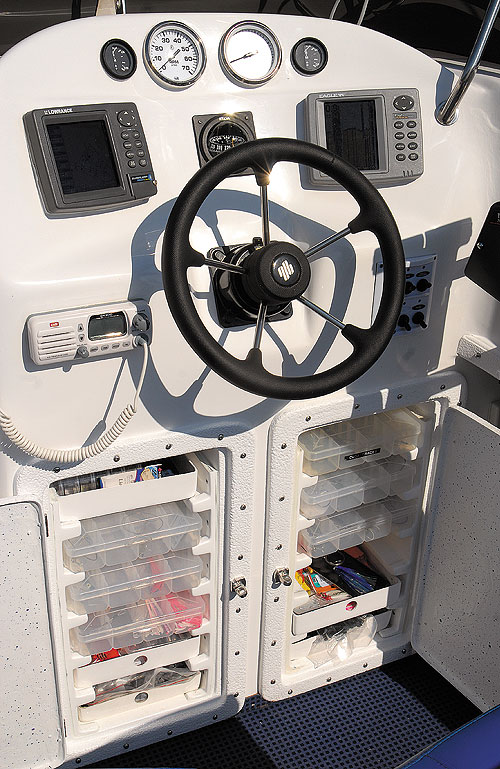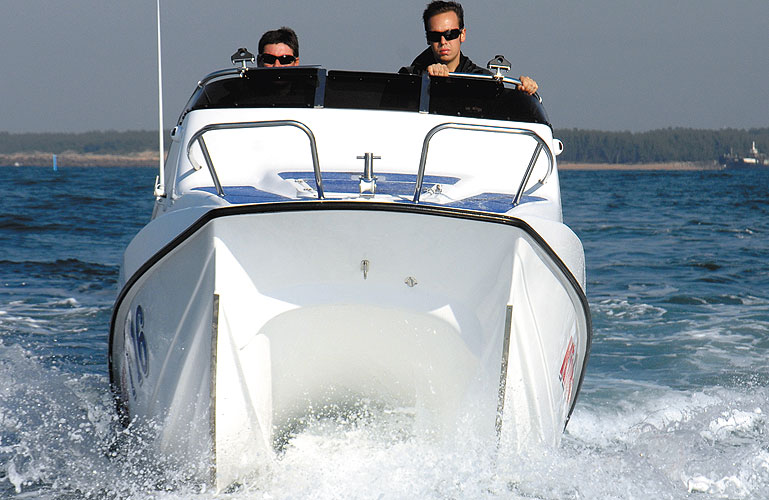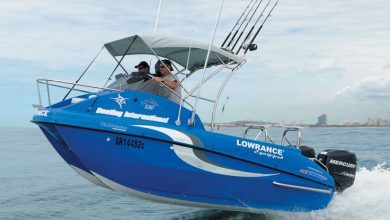F16
Tested by Erwin Bursik (SKI-BOAT November/December 2009)

AT A GLANCE
Length: 4.95m
Beam: 2.2m
Draft: 300mm
Approx weight: 460kg
Fuel capacity: 100 litres
Rated max hp: 2 x 70hp
Rated min hp: 2 x 40hp
Power as tested: 2 x 50hp Yamaha four-stroke trim-and-tilt motors
SOME men are never happy! And that is the case with Peter Motzouris, MD of Z-Craft. I don’t mean that in the “jolly” sense of the word, but rather that he’s never entirely satisfied with the design and building of the Z-Craft range of boats.
“You bleated about wanting an F16 with a forward console, so now you had better come to Richards Bay and test it,” was the message I heard upon answering a phone call early one morning a few weeks ago.
True to form, Peter had redesigned the popular F16 centre console ski-boat that came onto the market in late 2004, and has radically changed the top deck moulding to produce the new F16 forward console.
I could have asked him why it took so long, but feared the answer. He was bound to come out with something like, “I’ve only got two hands — and look at the new Kingcats I’ve made over the last few years.” Indeed, he has revolutionised Z-Craft’s boats in recent years.
GENERAL IMPRESSION
And there she was, proudly displayed at the water’s edge at Richards Bay Ski-Boat Club, looking quite a bit bigger than I had imagined. She was also very striking, with the strong forward design typical of most of Z-Craft’s range of offshore craft. The racy lines of the centre console version have given way to the more traditional Z-Craft looks — looks that really appeal to me, as I unashamedly prefer the forward console configuration in offshore craft.
Clambering aboard I was immediately taken with her overall layout. That first impression gathered in a few seconds told me, “Yes, I like it,” and after spending a good few hours on her out at sea off Richards Bay, like had turned to love.

CONDITIONS
For once Z-Craft and I experienced sea conditions that not only allowed this craft to show off her capabilities, but were also pleasant enough for me to enjoy the ride without having to fight the sea all morning. The southwesterly had all but died, but its effect on swell in that area, which generally moves in to the coast from the northeast, was to put a fair chop on the water. This chop got progressively worse as the wind swung around and started puffing from the northeast.
Those kind of conditions allow one to properly assess a craft’s performance and seakeeping ability, as well as simulate the sort of conditions that those of us who regularly fish this part of the coast know so well. This knowledge enabled me to truly appreciate the F16 FC and rate her performance in a sea that could be classed as “great fishing conditions”.
LAUNCHING AND TRAILERING
Gone are the days when Z-Craft outsourced its trailers and I had to review the trailer as well as the craft. These days Peter builds all his trailers inhouse to a standard design that has been perfected over years. This design has been proven by many, many Z-Craft owners who traditionally launch their craft from the beach and tow their rigs on the tortuous Moçambique roads.
Having recently followed Peter on the way through Swaziland and Moçambique en route to Guinjata, I had ample time to watch the performance of the trailer on the road at good speeds. Possibly more importantly, I could also watch how the craft on sat the trailer.
Minimal flexing of the trailer bed is essential so as not to transfer that flexing through to the hull of the craft. It’s all in the suspension, and experience has proved that the Z-Craft trailers do their job effectively, without putting strain on the craft they are supporting.
Backing boats into the water via a good slipway has become a non-exercise. It’s just too easy, as we experienced while putting the F16 FC into the water off Richards Bay. What’s more, using the drive-on method of reloading makes this side of boating a pleasure too.

MOTORS AND CONTROLS
Yamaha and Z-Craft have become synonymous over the many, many years that Peter has been a “Yammie” agent. It was no surprise, then, that twin Yamaha 50hp 4-stroke trim-and-tilt motors had been used to power the new F16 FC.
It was interesting to compare these new generation Yamaha motors and the way they powered this craft to what I remembered of the performance of the F16 CC with the same size motors five years ago. Even with the larger forward console and the additional wind resistance, I was pleasantly surprised at the performance these two motors permitted the craft to achieve.
One has to also take into account that with the forward console the human “cargo”, and therefore weight, is moved a long way forward when compared to the centre console version. That means that some of the power is required to sustain her attacking profile, that is slightly bow-up, instead of using 100% of the power to push the craft forward. No matter what I tried in an effort to justify use of bigger motors, I eventually had to concede that the twin 50hp Yamaha 4-strokes were ideal for the F16 forward console boat.
Throughout these exhaustive trials not only did the steering system and throttle/gear controls operate smoothly, but they also felt perfectly positioned for the skipper to operate.
HANDLING
In my mind, the perception of how a craft performs comes but a few minutes after I’ve had her under my control. What takes time, and a lot of time, is trying to confirm or reject that initial impression.
Taking the controls of the F16 forward console put me in a good mood straight away, and the moment I got her up onto the plane I remember thinking, “Peter, I told you so.” Just as I’d thought, the F16 worked well in a forward console model.
As she got onto the plane I could feel her hull separating from the water as her shoulders reached their designed planing stance. As the wetted areas of her sponsons decreased, her speed-over-water (SOW) climbed quickly. Like most of Peter’s craft, especially the Kingcats, the hulls like to ride bow-proud and plane on that attack angle without much bow-up- or down trim.
Trim is always important when one gets out to sea, as it’s usually necessary to adjust the craft’s ride to the sea conditions, but in the flat water of Richards Bay harbour, her designed ride was perfect. Naturally I tried trimming her, but reverted back to the design stance almost straight away, as this was undoubtedly her best ride. The only trim I then used was laterally to compensate for motor torque and crew positioning.
Standing at her controls with Danie Goosen from Z-Craft alongside me, I felt the weight distribution was ideal, and because I did not need to use any of the motors’ thrust to hold her bow up, this energy could be more productively used for forward propulsion. I proved this once and for all when I eventually took the F16 FC out to sea and moved north towards Dawson’s to get out of the bay water which, in my opinion, has a negative effect on any boat’s performance.
Having set a course to the north, I set her speed at 20 knots SOG, relaxed and gave her her head. It was then that I could really feel the way this hull reacted to whatever the sea was putting in our path.
First and foremost, I felt the ride on the F16 FC was substantially different to that of F16 CC. The racy feel of a low trajectory at speed, hugging the water’s surface, was gone, and there was a more sedate feel as the water’s action seemed to manifest itself behind where we were standing, thus giving a softer ride. In addition, from this higher forward position I felt I could not only see better, but could also judge the sea conditions more accurately to achieve the comfort I was looking for on the long ride north.
Even though we did not have excessive wind chop, there was enough to establish her performance both directly into the sea, and running with the wind and swell, especially just prior to returning to the harbour when the northeasterly started to blow. I enjoyed her ride and her reaction to trim, especially when running with the sea. I was able to hold her stance and maintain an even SOW during the return run.
Where the swell was peaking a little more, just behind the backline, I was able to seriously test her surf work ability. I raced down the front of a swell and swung her round at speed to face the swell, before thrusting her out of the hole to climb over it, get onto the plane and back out to sea. I experienced no cavitation and it was extremely easy to pull her out of the turn.
Danie and I trolled a lot for snoek — after all, you have to have some fun while “working” — and through out the hour or so we trolled both at Rapala speed and slower, she behaved well, giving a comfortable and very stable ride even though we caught no snoek.
 LAYOUT
LAYOUT
Peter builds a great boat and he is proud of that. He makes no excuses for the fact that everything has to be just right, even if it costs a little more. The thought and detail he has put into the F16 FC are exemplary.
As eager as he was to explain every facet of the layout, I was equally keen to appreciate the finishing on this craft. Attention to detail and quality of the hardware fitted certainly makes the end product more practical and adds extensively to its overall appearance.
In the F16 FC the helm station is substantial for a craft of this size. Not only does it provide the skipper with a lot of protection, but it also allows for a neat and spacious layout for the array of electronics and instrumentation. The site of the steering wheel and its positioning relative to the side-mounted controls make skippering her a pleasure, whether one is standing at the wheel when heading at speed to the fishing grounds or sitting during the long hours of trolling.
The deck layout on the F16 FC follows the standard and style of most of the Z-Craft ski-boat range, a layout that has proven practical for game- and bottomfishing. However, in addition to the centre coffin hatch and the two longitudinal below-deck fish hatches, this craft has a solid transom that incorporates the motor wells and transom step.
As an extra, a deck table has been mounted on a gooseneck stand that allows it to be manoeuvred over the forward portion of the coffin hatch. Its raised outer rim will help prevent any thing placed on this table from sliding off. As a tackle, drinks/food or even a bait preparation table, I think it will be most useful.
Another nicety which Peter has incorporated onto the inner gunnels of the F16 is an upholstered inside gunnel cushion which looks and feels good.
FINISH
I don’t know whether it’s a sign of the high quality that consumers are demanding nowadays, or the natural progression towards perfection, but I have noticed a dramatic improvement in both the superficial finishes of most of the new offshore craft and, more importantly, the quality of the hardware that supports the finishes that first catch your eye.
The F16 FC is a great example of this. Not only are its fibreglassed hull and top deck beautifully moulded and solid to the feel, but it is also finished off with extras such as immaculate stainless-steel work which is very solid in construction, neatly fitted and polished to perfection.
She’s definitely a craft that will not only catch the eye of an avid ski-boater, but will also hold his attention for a longer and more admiring look.

CONCLUSION
I am very chuffed that Peter has produced the F16 forward console. Indeed, the craft’s basic hull which performed very well in the centre console version now has the space, comfort and increased fishability that the forward console layout offers the offshore angler.
She’s certainly a craft we will see a lot more of, especially amongst those who enjoy the wonderful fishing on offer off the Moçambique coast.





